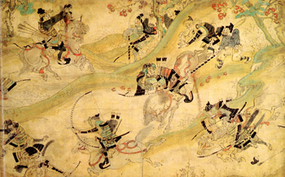 Akuto and musha-gari Source: http://1000ya.isis.ne.jp
Akuto and musha-gari Source: http://1000ya.isis.ne.jp On a certain morning in the eighth month of the 24th year of Ōei (1417), in a space beside the entrance to a private house between the Kyoto avenues of Ayano Kōji Ōmiya and Shijō Ōmiya, an incident occurred whereby a priest of the Hokke sect was assassinated by two individuals. The assassinated priest had been chased along Ōmiya road and had made his way north, finally seeking refuge in a private house. His assailants had made their way into that house, and there they had assassinated the priest. There was, however, no way that the people of the surrounding township would silently allow someone`s private home to be violated and a murder take place. They immediately flew out of their houses and apprehended the assailants. They then made their way to the samurai-dokoro of the Bakufu, and there presented the two culprits. (p.37)
As became clear during the subsequent investigation, the murderer was the leader of the two, who in the guise of a priest had killed the Hokke priest with a `great sword` (or daitō). The other member had apparently placed a bow and its case (or utsubo, 靫) in the vicinity of the crime. According to the testimony of the accused, the murdered priest had been a `katakiuchi`. What is particularly interesting about this case is that the person who recorded it their diary, Nakahara Yasutomi, was a highly regarded official who wrote down his impression of the case. In Nakahara`s view, it was an example of “the mysteries of divine will”. In other words, upon hearing that the murdered priest had been a `katakiuchi`, Nakahara chose to praise the murderers. So how about that. Nakahara did not consider what the two individuals had done as a bad thing, but appears to have thought that they should be thanked for their deed. (p.37)
In order to prove that this was not a peculiar characteristic of Nakahara`s way of thinking, Nakahara continued with the following “ただし、かくのごとき仮りごと、つねにあるのあいだ、信ずるにおよばず” (However, this is a commonly repeated lie (that the murdered person was a katakiuchi), and so it cannot simply be believed). In other words, whether or not this was an example of katakiuchi was beside the point. The murdered priest clearly wasn`t a true katakiuchi, and there were many examples of people murdering others and then claiming the other party was a katakiuchi in order to escape punishment. (p.37-38)
For example, in the 4th year of Eikyo (1432) on the estate of Nishi Kawai in the province of Harima (now part of Kasai City in Hyogo prefecture), two samurai by the name of Nakamura Sado Nyūdō and Kōzuki Yamato no Kuni killed another local samurai named Kōhana Hikozaemon Nyūdō and appropriated his tribute. At least, this was the charge that the Bakufu made against the owner of the estate, the shrine of Iwashimizu Hachimangū. Iwashimizu then attempted to come up with a variety of counter arguments to justify the killing. They claimed that Kōhana had been their own retainer in the service of a local official, and part of the younger band of retainers, while also being a `katakiuchi`. In the end Iwashimizu lost the case. They had been prepared to claim that Kōhana was a katakiuchi despite the fact that it wasn`t true. Given this state of affairs, it is fairly clear that for the society at the time, to kill a katakiuchi was not itself regarded as illegal. (p.38-39)
By using these social mores, each party attempted to justify murder. As Nakahara had written, it was fairly common to see people who claimed that they had killed a `katakiuchi` in order to justify the killing. When one considers that they were brazen enough to use this defence in the Bakufu`s own law courts, then there is a very high probability that killing a katakiuchi was regarded by society as normal. In the second month of the 2nd year of Kenan (1362), a legal official for the Muromachi Bakufu, when asked to give an opinion on the criminality of katakiuchi, wrote about a precedent in the `Goseibai Shikimoku` (御成敗式目) as ratified by the Kamakura Bakufu. According to this document, if the offspring of an individual kill their father`s enemy, they will be found innocent. Yet if one digs a little deeper, one finds that in the original Goseibai Shikimoku, there is no such clause. Rather, Article 10 of the original document states the exact opposite. (p.39)
If the offspring of an individual should kill their father`s enemy, both the father and his offspring shall be punished. This error in interpretation can either be attributed to a simple mistake on the part of the legal official, or else it might have been a deliberate attempt by the official to change the meaning of Article 10. In truth, it is difficult to decide either way. Nevertheless, while the practice of katakiuchi may have been banned within the original Goseibai Shikimoku, by the Muromachi era even officers of the law had diverted from the original interpretation (or else ignored it) and thus there began to appear people attempting to justify katakiuchi. (p.39)
 RSS Feed
RSS Feed